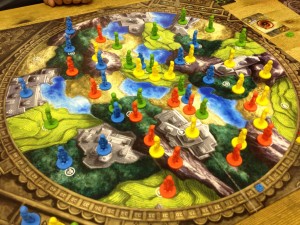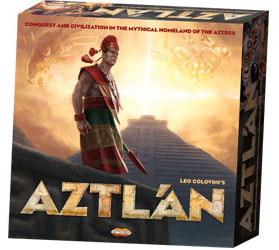Review: Aztlán
Posted by James (admin) on July 19th, 2013
 Aztlán is an area-control game which looks innocent on the surface but, underneath, there’s the constant lure to sabotage your opponents which can be devastating – which is one aspect that attracted me to the game. Plus, it’s by Leo Colovini and I find I like his games (Atlantis, Masons, Clans, Carolus Magnus).
Aztlán is an area-control game which looks innocent on the surface but, underneath, there’s the constant lure to sabotage your opponents which can be devastating – which is one aspect that attracted me to the game. Plus, it’s by Leo Colovini and I find I like his games (Atlantis, Masons, Clans, Carolus Magnus).
Each player is an Aztec tribe and the board shows a land divided into territories and each territory has a terrain type (jungle, mountains, etc.) The game lasts 5 rounds (Ages) during which players take turns, and the player with the most victory points (VPs) at the end of the game wins. On their turn, a player must place 1 of their people figures into the board, plus the player can optionally move 1 of their figures on the board to an adjacent region. Figures can be placed in, and moved to, any region even if opponents’ figures are there. Not many figures get placed each round (in a 4-player game, each player places 7 in the first Age and then one fewer each round after that so only 3 figures in round 5).
So far, the game may sound very ordinary; however, there are two game mechanics which define the game and make it entertainingly different: Power Cards, and the choice whether to Battle or Coexist.
Each player starts the game with an identical hand of 6 Power Cards and each Power Card shows a terrain type and a number. At the start of each Age, before any figure placement starts, each player secretly chooses one of their remaining Power Cards: the number (4-9) determines how strong their figures will be if a battle occurs, and the terrain type determines for which terrain they will score VPs for at the end of the Age. Each card can only be used once per game so players always end with one card unused which may earn then VPs (higher numbered cards score more VPs).
Once all players have finished placing all their figures for the Age, any territories which contain figures of more than 1 player must be individually resolved. Each player involved in a territory calculates their strength (number of figures multiplied by the number on their Power Card). Whoever has the highest total chooses whether to Battle (all figures of all players other than the strongest are removed from the territory) or to Coexist (everyone in the space remains living peacefully and the strongest player receives a Prosperity Card). In the case of a tie, all tied players’ figures remain, and all others are removed. Prosperity Cards give various one-off abilities (like winning a tie when resolving a space) or extra VPs so they can be quite powerful but are randomly drawn.
This is an all-or-nothing deal – a player can not choose to coexist with some players and battle others in a single territory. However, the choice about each territory is completely separate so a player can choose to battle an opponent in one space and coexist in another.
Once all territories have been resolved, players calculate VPs by scoring each group of contiguous territories where they have figures (called a Domain). They score 1 VP for each territory in a Domain of any type, plus VPs equal to the number of territories that are the same terrain as shown on their current Power Card squared. For example, a Domain of 6 territories (6 VPs) containing 3 jungle when the player has the jungle Power Card territories (9 VP) would score 7 + 9 = 13 VPs. So, having lots of the correct terrain in one single Domain is how the big points are earned.
 Overall, Aztlán is a game of politeness followed by merciless devastation; of friends and then grudge-bearing enemies. When resolving territories, Coexisting is common at the start of the game because the Prosperity Cards are very useful, the board isn’t too crowded, and no-one wants to make enemies too early on. However, there’s usually a turning point (around 3rd or 4th Age) where at least 1 player with stronger forces in multiple places suddenly chooses Battle and wipes out a swathe of enemies, especially if there are lots of figures in the regions in question.
Overall, Aztlán is a game of politeness followed by merciless devastation; of friends and then grudge-bearing enemies. When resolving territories, Coexisting is common at the start of the game because the Prosperity Cards are very useful, the board isn’t too crowded, and no-one wants to make enemies too early on. However, there’s usually a turning point (around 3rd or 4th Age) where at least 1 player with stronger forces in multiple places suddenly chooses Battle and wipes out a swathe of enemies, especially if there are lots of figures in the regions in question.
So, Aztlán is definitely not a game for you if you are easily offended because players can quickly have their position destroyed by another player, even if they were kind when the tables were reversed in a previous round. So, betrayal and disaster are a constant spectre. I found people either battled everywhere they could or not at all – I think this is natural as you may as well take full advantage once you’ve started killing off enemies, especially as you know they’ll probably do the same to you if they have the chance so best to reduce their power while you have the chance.
The game moves quickly as each turn is simply place 1 figure and maybe move 1 figure. You don’t place that many figures so you need to make them all count. As a result, you need to balance being subtle about your intentions with being in position to score VPs. If it’s obvious which terrain you’re scoring then other players may try to stop you plus are usually sure what number Power Card you have too. Also, as you have 1 fewer turns each Age, you need to think about which territory you may aim for next round so you are in position to reach and hold them.
Having figures in the right terrains is one thing, but if you want to earn lots of VPs then you need them to be connected in one Domain. This adds lots more to think about as you not only need to join them but want to find a way to do so that your big score doesn’t fall apart because you get kicked out of one key territory.
So, there’s plenty of interesting decisions to be made in the game. Choosing which Power Card to use is an interesting choice. Do you use higher strength cards early so you dominate early on, or use them later when other players have spent theirs? Is it better to not use a powerful card to score its VPs at the end of the game, or will you be better off using it? Plus, it’s good to consider what cards an opponent has already played to understand what territory they may be scoring this round plus what strength their figures may be in a fight.
Aztlán can be quite a brutal game, which is acceptable in a short-ish game; however, one issue some players may not like is that it can be difficult to recover from having many figures removed even if you hold stronger cards. Also, I’m not sure how much variety there is in replay of Aztlán if you played it a lot; however, that hasn’t diminish my enjoyment of the game when I’ve played it.
The game plays 2-4 players but the 2-player game is a bit different because you play 2 sets of figures each and you swap the teams you’re playing each Age. I haven’t tried it 2-player but it does sound a bit odd. I think 4 players is the best amount of players because of the inherent problem with many 3-player games involving conflict where 2 players fight whilst the other player is left relatively strong.
With regards to the components, the figures are nicely produced and weighty. The Aztec temples used to mark player scores on the scoring track are quite cute as they come in two parts with the bottom half being added on to the top half when you lap the score track. I always like a game with a bespoke inner inside the box which holds all the game pieces securely. The only negative comment I have about the physical aspects of the game is that the colours used for the terrains on the board are quite bright – normally this would be fine but it can take a moment to clearly see which terrain is where and the brightly coloured figures make it very busy.
In the end, I enjoyed my games of Aztlán as there is lots to think about all the time and there’s little downtime too. It’s one of those games that has a slightly nervous atmosphere as you try to decide how to use your limited actions to get the big score whilst you’re paranoid about other players and braced for everything to go very wrong very quickly.
James.
[Played with 3 and 4 players]

